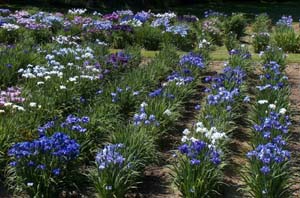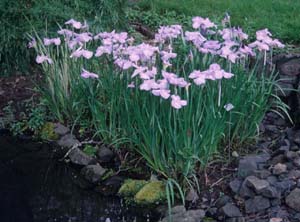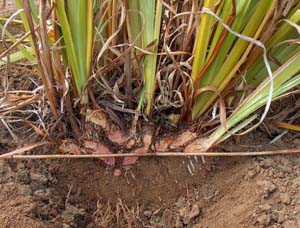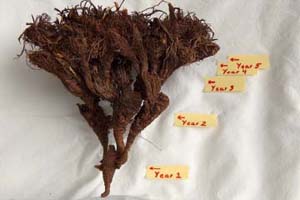by Chad Harris
Written for and Published in The Review of The Society For Japanese Irises Volume 47, Number 1, Spring 2010
The cultural needs of Iris ensata are a bit more exacting than many other species of irises. Gardeners including iris buffs get frustrated with the lack of growth, bloom, or total loss of a plant after planting in their garden. The four basic needs to grow Iris ensata successfully are: soil, water, sun, and transplanting.

The soil in a perennial bed is the foundation. With a proper foundation laid down the structure of a plant can grow and thrive. Iris ensata demands lose loamy soil that is slightly acidic and very high in organic matter. Compacted soil does not breathe; plants need oxygen at their roots. The soil should be worked up and loose to a depth of ten to twelve inches. Organic matter needs to be added at every transplanting. Whatever you use, aged manures with fillers or leaf compost, it should make up approximately twenty to thirty percent of your soil mixture. The ideal PH range of your soil should be 5.8 to 6.8.
Water, water, water; wet in the spring and moist in the summer. Saturated soils near natural ponds or streams is preferred but only if the crown of the plant is above the water line. A very deep watering once or twice a week is preferred over shallow everyday watering.
It is my belief that not conditioning the soil properly and under watering are the primary reasons that people loose their plants.

Iris ensata is a full sun iris growing naturally in open wet fields in Asia. It requires a minimum of 6 hours of sun to grow but would increase and bloom better with 10 to 12 hours of sun. In high heat areas such as the Mid West or even a back yard patio, afternoon shading will benefit the bloom and plant.

The growth habit of Iris ensata demands transplanting every three growing seasons, some require transplanting every two. New plants of two to four fans are planted three inches deep. If sun, soil, and water needs are met, by the second growing season the crown will be two inches deep with eight to sixteen fans. The third growing season the crown will be one inch deep with thirty two to sixty four fans. Do you see the pattern here? By the fourth growing season the crown is at or above soil surface with one hundred twenty eight to two hundred fifty six fans and no place for the new increase or roots to go. At this point you are on borrowed time and may lose the plant.

Demanding – yes, difficult – no. Give a cultivar a try and enjoy the June bloom of Iris ensata.